Florida Palms and Cycads
On this page - Sabal Palm, Coconut Palm, Saw Palmetto, Florida Royal Palm, Florida Silver Palm, Everglades Palm, Florida Thatch Palm, Key Thatch Palm, Buccaneer Palm, Scrub Palmetto, Needle Palm,
Dwarf Palmetto, Coontie
Palms are the sole members of the family Arecaceae, perennial flowering plants in the monocot order of Arecales with an estimated 2,600 species worldwide. Florida has its own 12 native species, those and several non-native palms are also widely cultivated for use in commercial and residential landscape designs. Palms are rightly associated with tropical climates, most species are naturally concentrated between 30°N and 30°S lattitudes.
Various human civilizations around the world have a long history of relationships with palms that continue to this day - using various palms and parts of palms as food, for building materials, storage containers and utensils, medicines, oils, wax, high quality charcoal, alcohol and even wine, historical records show that date palms were cultivated in Mesopotamia as an important food source over 5000 years ago.
Those palms that grow with a single stem or trunk exceeding 20 feet in height are referred to as palm "trees".
While many palms do conform to that habit of growth, others are smaller and more shrub like, there are species that have evolved as climbers, even having recurved spines on the stem or leaves to grasp tree trunks, some species form clumps of multiple stems, some species have no visable stem at all.
Types of palm leaves shown below in order -
pinnate, palmate, costapalmate, pinnately compound
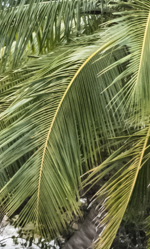
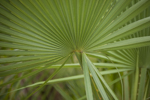
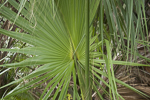
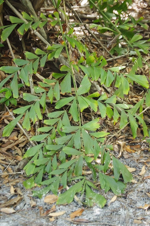
Sabal Palm - Sabal palmetto
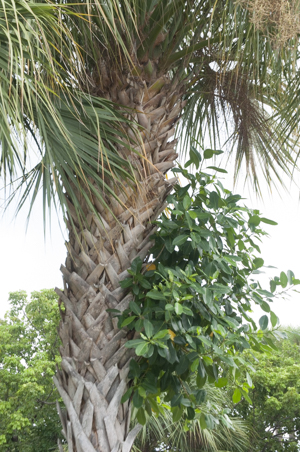
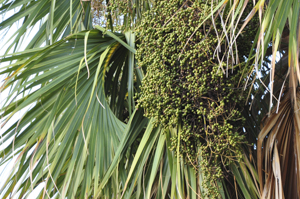
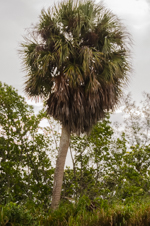
A.K.A. - Cabbage palm, Swamp cabbage palm, Cabbage palmetto
This is the state tree of Florida and South Carolina, it is also the most widespread palm in the state of Florida.
Sabal palms can grow to 45 feet or taller, grows well in almost any soil type, is drought resistant and can withstand flooding by fresh or slightly brackish water and salt spray, however not direct salt water contact with its root zone. Sabal palms are also fire resistant.
Leaves (or "fronds") are strongly curved, costapalmate, fan-shaped with leaf blades 3–4 feet long and petioles (stems) 3–6 feet long. The base of the leaf stems, called "boot jacks" or simply "boots" persist on the trunk of some, but not all of these trees.
This palm tree is also a source of "hearts of palm" locally know as "swamp cabbage" which is harvested from the leaf bud of young trees - unfortunately killing the tree in the process.
Coconut Palm - Cocos nucifera
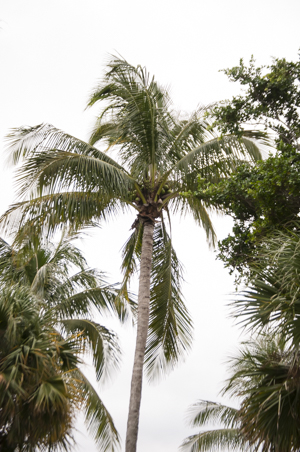
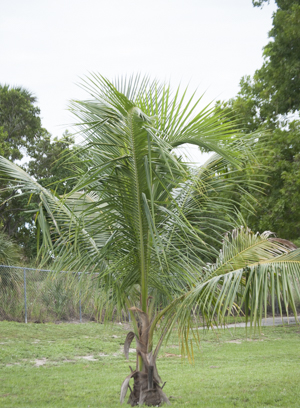
A.K.A - Coco, Coco-da-bahia, or Coconut-of-the-beach
Not native.
Origins are believed to be the Southeast Asia pacific region of Oceania, imported to India and then Africa, from Africa it was brought to the tropical Americas and other tropical locations around the world.
Coconut palms have a single, gray colored (often curved) trunk that can grow to 100 feet tall, topped with a crown of pinnately compound leaves or "fronds" spreading to 25 feet, each frond is gently curved, 12-15 feet long with each individual leaflet or "pinnae" being 2-3 feet in length.
Coconut palms grow well in south Florida agricultural zones 11-12 and may live for 100 years. Flowering occurs throughout the year in tropical locations the inflorescence or flower stalk is up to 4 feet long, yellowish flowers from a canoe shaped spathe that emerges from among the leaf stalks, fruit is geen when unripe turning brown as it matures.
Saw Palmetto - Serenoa repens
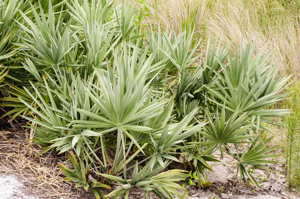
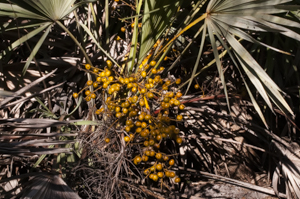
The Saw palmetto is a native clump forming palm that grows in dense thickets throughout the state and the southeastern United States. This is a very long lived palm, with some estimated to be over 500 years old. Fire and drought resistant, saw palmetto grows in dry or wet flatwoods, sand pine scrub, moist hammocks and lowland forests.
Stems may be procumbent or ascending, 10-15 feet long, leaves are palmate, leaf petioles are serrated giving this plant its common name.
Creamy white flowers in the late spring, early summer followed by berries ripening from orange to black are a staple food for native wildlife, black bears, deer, Extracts of the fruit are being studied as possible treatments for urinary and prostate conditions.
(Note - A permit is required to legally harvest berries from the Saw palmetto, and harvesting on any state/public land is strictly prohibited.)
Florida Royal Palm - Roystonea regia
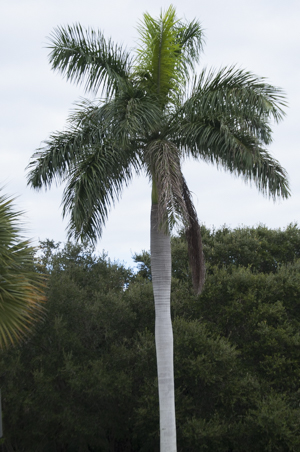
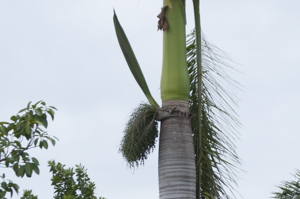
Native to South Florida. Endangered in the wild within the state, widely cultivated as a decorative landscape palm in tropical and sub-tropical locations.
The Royal Palm is a large palm with a light gray, straight trunk up to 98 - 100 feet tall and 24 inches in diameter, obvious characteristics of this palm (other than its large size) are the green "crown shaft" above the trunk and the slight bulge or swellings of the trunk, one is just below the crown shaft and another one near the base of the trunk.
The leaves or fronds are 13-15 feet long, pinnately compound and form a crown 25 - 30 feet across. Inflorescence 3 feet long with hundreds of creamy white flowers are followed by green berries turning red to black in late summer, fruit is consumed by birds. Grows well in moist to wet fertile soils, also drought tolorent when well established.
Florida Silver Palm - Coccothrinax argentata
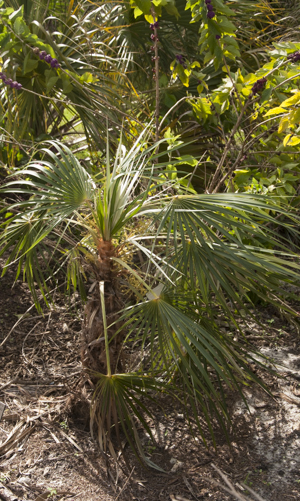
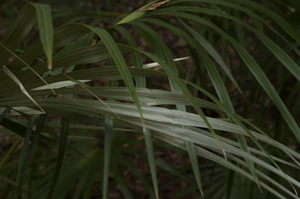
A.K.A. Silver Thatch Palm
Endangered, native to South Florida.
Two sub-species of the Silver palm catorgarized in Florida, Coccothrinax argentata subsp. garberi found on the Atlantic coastal ridge and Coccothrinax argentata subsp. argentata , found in the Keys.
A smaller palm at 6 -15 feet tall with a 6 foot spread, rarely to 20 feet. Natural habitat is the rocky, calcareous, or sandy soils of southern and south-eastern Florida rockland, coastal scrub and coastal hammock habitats.
Leaves of the Florida silver palm are fan shaped, dark green above and silver below, deeply divided with slender unarmed petoiles (leaf stems) that form a rounded canopy 6-7 feet across.
Everglades Palm - Acoelorraphe wrightii
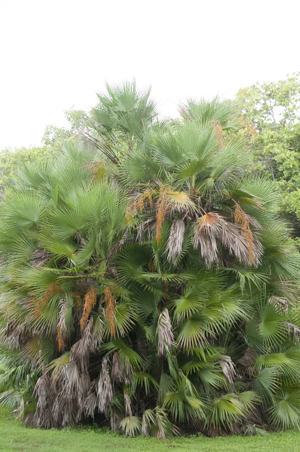
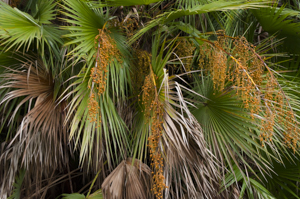
Native, threatened in the wild.
Also known as the Paurotis palm or Madeira palm.
Clump forming palm with slender stems growing to 25-30 feet tall, leaves are fan shaped, 2 feet across, petolies are up to 3 (plus) feet long and armed with sharp, curved teeth along the edges. Stems of this palm are covered with fiber and the persistent leaf boots. White flowers are followed by 1/4 inch round berries turn from green to orange and finally black when completely ripened in late summer.
Widely cultivated, its historical range is limited to low lying wet forested areas of extreme south-west Florida, once extensively harvested in the Everglades, it is now a protected species in the wild.
Florida Thatch Palm - Thrinax radiata
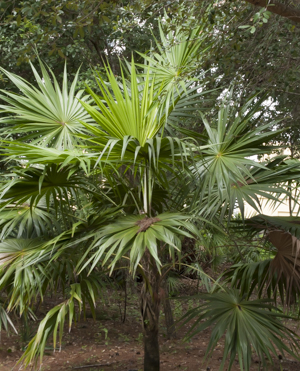
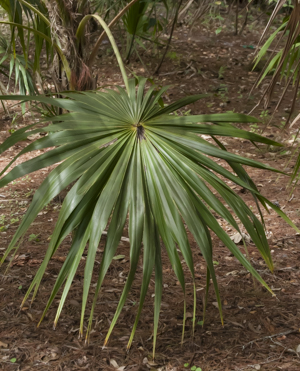
Endangered native palm, natural range in Florida is limited to the Keys and the coastal areas of Miami-Dade and Collier counties. The Florida thatch palm naturally grows on the calcareous and sandy, well drained soils of rock pinelands, maritime hammocks and coastal scrub habitat.
Florida thatch palm has a solitary growth habit with a slender stem 3-5 inches in diameter, it grows very slowly to 20-25 feet tall, in full sun producing a compact rounded canopy, when growing in a more shaded location it developes a loose, spreading and airy canopy.
12-20 circular palmate fronds, 4-5 feet wide on slender, unarmed stems 2-3 feet long. A V-shaped hastula protrudes from the center of the induplicate frond, and the frond segments are split for about half of their length and have pendant, split tips.
Inflorencense with white flowers 3 feet or more in length arch downward, the fruit is a drupe 1/4 inch in diameter and is also white.
Key Thatch Palm - Leucothrinax morrisii
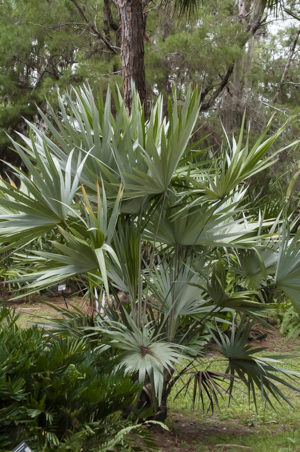
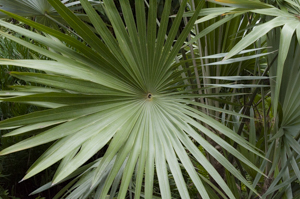
A.K.A. Brittle Thatch Palm
Native to the extreme southern portions of mainland Florida, the Florida Keys and the West Indies, this palm tree is listed as a threatened species within Florida.
This palm grows slowly as a small tree 20 - 35 feet tall with a single smooth stem/trunk. Fronds are palmate, 3 1/2 feet wide green/blue green on upper surface and silvery colored on the undersides, held on 1-3 ft. long petioles (stems) and forming a crown 8-12 feet across. Grows in full sun to partial shade on a variety of soil types.
Buccaneer Palm - Pseudophoenix sargentii
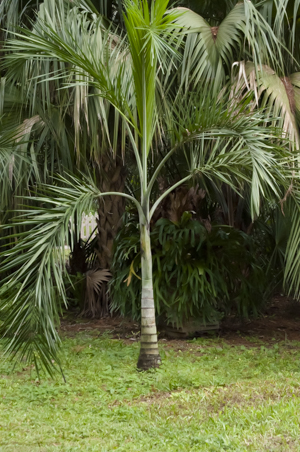
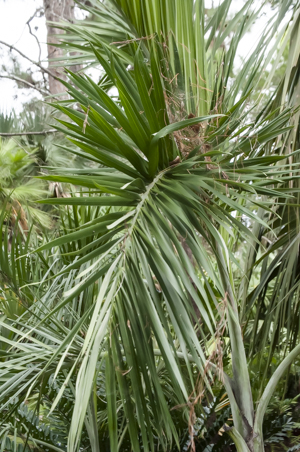
A.K.A. Florida Cherry Palm, Sargents Palm
Native to the southeastern tip of Florida and the Florida Keys. Endangered in Florida, this species is also native to the northern Caribbean and eastern Mexico.
A solitary palm, 10-20 feet tall at maturity with an 8 to 10 foot canopy spread, the stem is gray-green when young, gray when older and has prominant brown leaf scars forming rings. Fronds are pinnate, 4 to 9 feet long with reduplicate leaflets that are green above and silvery below, the leaflets are arranged at various planes along the rachis. Inflorescence erect or arching to 3 feet long with many branches. Fruit is 3 lobed, and a bright scarlet red color.
Occurs naturally near the coast on the limestone and dry sandy soils of tropical rockland habitat, it is very wind resistant and is tolerant of occasional salt spray and saltwater innundation.
Scrub Palmetto - Sabal etonia
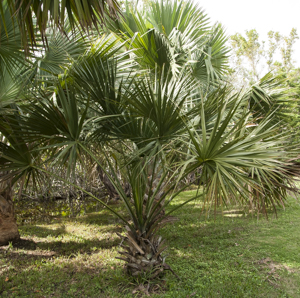
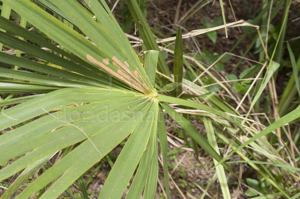
A.K.A. - Miami Palmetto, Dwarf Palmetto
Native palm, endemic to Florida.
The scrub palmetto is found on the deep white sands of the Central Florida Ridge and the Atlantic Coastal Ridge in the sand pine and oak scrub understory.
The stem of this palm is usually underground, on rare occasion it may be extend 2-3 feet above ground level.
Costapalmate fronds are 3 feet across with 4-7 fronds forming a crown 4-5 feet wide. Fronds are recurving with stiff, deeply split segments yellow-green in color with fibers produced at segment margins, tips of segments are bifurcate or split in a Y shape, petiole is unarmed. Long tapering triangular hastula.
Inflorescences with creamy white flowers in spring and summer 1/2 the length of the leaves, sometimes as long as the leaves. Fruit is a black globose berry about a half inch long.
Needle Palm - Rhapidophyllum hystrix
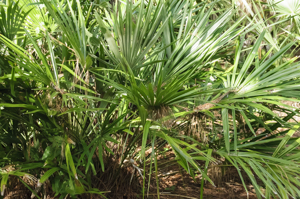
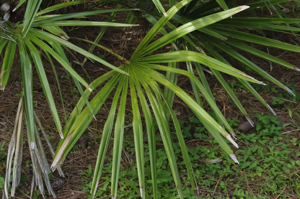
A.K.A. - Blue Palmetto, Porcupine Palm
Native palm
Named for the stiff 4-6 inch spines that form around the base to protect the leaf bud from grazing animals. Reputed to be one of the most cold hardy of the palms, it can survive temperatures well below freezing.
Needle palms have been vouchered in most of the central and northern counties of Florida. Source - Atlas of Florida Plants
This is a slow growing, shrubby palm with a short thick trunk with many dark green palmate leaves that are up to 3 feet across with narrow leaf segments are split for most of their length, this is clump forming palmproducing suckers from the base eventually growing in a mounded shape 6-8 feet tall with a more or less equal spread.
Natural habitat is the rich organic soils of moist to wet woodlands, stream banks and ravines. Flowers in the spring, the fruit is a reddish-brown, hairy and foul smelling drupe, eaten by black bears.
Dwarf Palmetto - Sabal minor
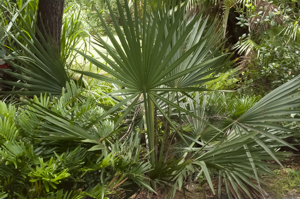
A.K.A. - Bluestem Palm, Little Bluestem, Latanier
Native palm.
This palm grows mainly on moist soils of mesic hammocks, floodplains and swamps but may also be found on drier sites. Usually with an underground stem and 4-10 weakly costapalmate leaves rising 2 to 10 feet above ground level. Each grayish-green leaf is 4 to 6 feet long including the petolies, leaflets are 31 inches long and split for slightly less that half that length, the leaf is held on pretty much on a single plane, it has little to no arch or curve.
Very cold hardy, withstanding freezing temperatures. Flowers in spring and summer.
Cootie Palm - Zamia integrifolia
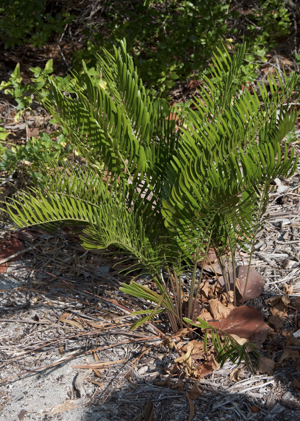
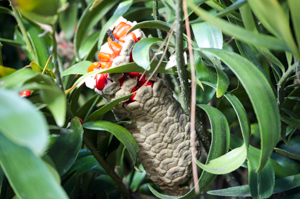
Family - Zamiaceae
A.K.A. - Florida Arrowroot
Florida's and North America's only native cycad, coontie is often incorrectly referred to as a "palm" because it resembles a palms general physical characteristics.
Coontie grows very slowly from a large underground stem as a many stemmed, clump forming shrub up to 4 feet tall with an approximate equal spread. Leaves are spirally arranged, pinnately compound, up to 39 inches long, with 5-30 pairs of 4-8 inch long leaflets.
Wild coontie naturally grows in sandy, slightly acidic to circumneutral pH soils in the understory of Florida's upland hardwood forests, high pine forests and coastal maritime hammocks. It is dioecious, having seperate male and female plants, all parts of coontie are toxic if consumed.